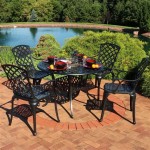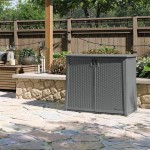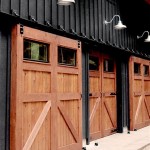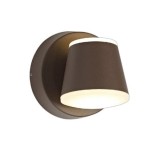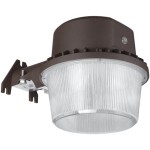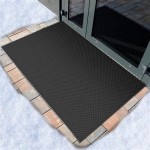Lazy Susan For Outdoor Table With Umbrella: Functionality and Considerations
The integration of a lazy Susan into an outdoor table designed for umbrella use presents a unique combination of functionality and aesthetic appeal. This configuration allows for enhanced dining experiences, promoting shared access to food and beverages while maintaining the comfort of shade provided by the umbrella. Understanding the nuances of selecting, installing, and maintaining such a setup is crucial for maximizing its benefits and ensuring long-term enjoyment.
Outdoor lazy Susans are not simply repurposed indoor versions. They are specifically engineered to withstand environmental factors such as sunlight, moisture, and temperature fluctuations. Materials like high-density polyethylene (HDPE), teak, and powder-coated aluminum are commonly used due to their durability and resistance to weathering. Before committing to a purchase, a careful evaluation of the table's design, the umbrella's compatibility, and the intended use of the lazy Susan is highly recommended.
Optimizing Space and Accessibility
One of the primary advantages of incorporating a lazy Susan into an outdoor table is the optimization of space and accessibility. Without a rotating element, individuals seated around a large table may struggle to reach dishes placed in the center. The lazy Susan eliminates this issue by allowing everyone to easily access all items without having to stretch or ask others to pass them. This promotes a more relaxed and convivial dining atmosphere, especially during gatherings with multiple guests.
The placement of the lazy Susan relative to the umbrella is also a key consideration. Typically, the lazy Susan is centered on the table, and the umbrella pole passes through a designated hole in its center. The diameter of the lazy Susan should be carefully chosen to ensure it doesn't interfere with legroom or extend too close to the table's edge. A general rule of thumb is to leave at least 12 inches of space between the lazy Susan's edge and the table's perimeter.
Furthermore, the height of the lazy Susan should be factored into the overall table height, especially when considering the comfort of diners. A lazy Susan that is too tall can make it awkward to reach dishes, while one that is too low may be difficult to rotate. The ideal height will depend on the specific dimensions of the table and chairs, but generally, a height of 1 to 2 inches is considered optimal.
The weight capacity of the lazy Susan is another important aspect to consider. Overloading it can lead to damage or failure, potentially causing inconvenience or even injury. Always refer to the manufacturer's specifications to determine the maximum weight it can safely support. Consider the types of dishes and serving platters that will typically be placed on the lazy Susan when making this assessment. For heavier items, such as ceramic serving dishes or large beverage containers, a lazy Susan with a higher weight capacity is essential.
The smooth rotation of the lazy Susan is crucial for effortless access to items. High-quality bearings are essential for achieving this. Look for lazy Susans that utilize ball bearings made from durable materials like stainless steel or nylon. These bearings are less prone to corrosion and provide a smoother, quieter rotation than cheaper alternatives. Regularly cleaning the bearings and applying lubricant can further enhance their performance and longevity.
Material Selection and Weather Resistance
The choice of materials for an outdoor lazy Susan is paramount, as it directly impacts its durability and resistance to the elements. Different materials offer varying degrees of protection against UV radiation, moisture, and temperature fluctuations. Selecting materials appropriate for the local climate is essential for ensuring the longevity of the product.
HDPE is a popular choice due to its exceptional weather resistance and low maintenance requirements. It is impervious to moisture, UV radiation, and insects, making it ideal for outdoor use. HDPE is also relatively lightweight and easy to clean. However, it may not offer the same aesthetic appeal as natural materials like wood.
Teak is a naturally durable hardwood that is prized for its beauty and resistance to decay. It contains natural oils that repel water and insects, making it well-suited for outdoor environments. Teak will naturally weather to a silver-gray color over time if left untreated, but can be maintained with regular oiling. Teak lazy Susans generally require a higher initial investment compared to HDPE models.
Powder-coated aluminum is another excellent option, particularly for its strength and lightweight properties. The powder coating provides a protective layer against corrosion and UV damage. Aluminum lazy Susans are typically very easy to clean and maintain. They are also available in a wide range of colors and styles, making it easy to match them to existing outdoor furniture.
Beyond the primary materials, the hardware used in the lazy Susan's construction is also important. Stainless steel screws and fasteners are essential for preventing rust and corrosion. The bearings should also be made from weather-resistant materials, such as stainless steel or nylon. Regular inspection and maintenance of the hardware can help to prevent premature failure.
Consider the overall style and aesthetic of the outdoor table and surrounding environment when selecting materials. A rustic teak lazy Susan may complement a traditional wooden table, while a sleek aluminum model may be more appropriate for a modern patio setting. The lazy Susan should seamlessly integrate with the existing furniture and décor to create a cohesive and visually appealing outdoor space.
Umbrella Compatibility and Installation Considerations
The successful integration of a lazy Susan with an outdoor table that accommodates an umbrella hinges on ensuring proper compatibility and following correct installation procedures. The key is to confirm that the umbrella pole can pass freely through the designated hole in the lazy Susan and that the lazy Susan itself doesn't interfere with the umbrella's operation.
The diameter of the umbrella pole hole in the lazy Susan is a critical measurement. It should be slightly larger than the diameter of the umbrella pole to allow for easy insertion and removal. Measure the diameter of the umbrella pole before purchasing a lazy Susan to ensure a proper fit. Some lazy Susans may come with adjustable inserts to accommodate different pole sizes.
The height of the umbrella base relative to the lazy Susan is another important consideration. The umbrella base should be stable and secure, and it should not interfere with the rotation of the lazy Susan. If the umbrella base is too tall, it may be necessary to raise the lazy Susan slightly using spacers. Conversely, if the umbrella base is too low, it may obstruct the rotation of the lazy Susan.
During installation, carefully center the lazy Susan on the table and ensure that the umbrella pole hole is aligned with the hole in the table. Some lazy Susans may have mounting hardware that allows them to be secured to the table, while others may simply rest on the surface. If using mounting hardware, follow the manufacturer's instructions carefully to avoid damaging the table.
Regularly inspect the umbrella pole, base, and lazy Susan for any signs of wear or damage. Tighten any loose screws or bolts and lubricate the bearings to ensure smooth rotation. Cover the lazy Susan when not in use to protect it from the elements and prolong its lifespan. A well-maintained lazy Susan will provide years of reliable service and enhance the enjoyment of outdoor dining.
The choice of umbrella style can also affect the functionality of the lazy Susan. A center-pole umbrella is the most common type and is generally compatible with most lazy Susan designs. However, cantilever umbrellas, which have the pole positioned to the side, may present challenges. Ensure that the cantilever umbrella's base is stable and does not interfere with the rotation of the lazy Susan.

Lazy Susan W Umbrella Hole Outdoor Patio Accessories Tropitone

Outdoor Lazy Susan With Hole For Umbrella Bar Products

Extra Large Lazy Susan Patio Set Garden Furniture With Parasol Etsy

Outdoor Wood Lazy Susan For Patio Table With Or Without Umbrella Hole Etsy

Patio Store Paragon Casual Lazy Susan Table Top With Umbrella Hole

Dining Table And Chairs With Umbrella Has A Lazy Susan In The Middle

Outdoor Lazy Susan With Hole For Umbrella Bar Products

Large Round Eucalyptus Wood 63 Lazy Susan Dining Table Outdoor Set

Stone 2 7m Parasol Garden Umbrella Lazy Susan

24 Inch Glass Lazy Susan Westminster Teak

